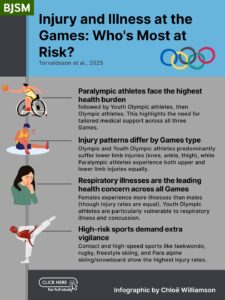Why is this study important?
Athletes competing at the Olympic, Youth Olympic and Paralympic Games face high demands and a risk of injury and illness (1,2) which can threaten participation, performance and long-term health (3, 4). Systematic surveillance of injuries and illnesses is crucial for athlete health promotion and has been conducted during the Games for over a decade. Until now, there has been no comprehensive review of health problems across all three Games cohorts. Our systematic review and meta-analysis (5) provides a clearer picture of injury and illness patterns, and helps clinicians, researchers and sports organisations in their efforts to protect athlete health. By identifying the most common health problems and groups at risk it may be possible to target preventive measures where the need is greatest.
How did the study go about this?
We systematically reviewed all available studies that reported on injuries and illnesses among athletes during the Games. In total, 27 studies were included and analysed: 10 from the Olympic Games (2000-2022), 4 from the Youth Olympic Games (2012-2020) and 13 from the Paralympic Games (2002-2022). This allowed us to calculate the incidence of health problems and to examine differences between female and male athletes, summer and winter Games, different sports and different types of injuries and illnesses.
What did the study find?
Our findings showed that Paralympic athletes experienced the highest burden of injuries and illnesses, followed by Youth Olympic and Olympic athletes. In Olympic and Youth Olympic Games, injuries most often involved the lower limbs, while in Paralympic Games more injuries involved the upper limbs. Injuries were equally prevalent in females and males, but females experienced more illnesses, with respiratory illnesses being the most common illness across all Games. Youth Olympic athletes were particularly affected by respiratory illnesses and concussions. Sports characterised by high speed, frequent contact or large external forces, such as taekwondo, rugby, freestyle skiing and Para alpine skiing/snowboard, showed particularly high injury rates.
What are the key take-home points?
Our findings emphasise the need for targeted, context-specific strategies in prevention, tailored to the unique characteristics of each Games cohort, and to specific sport demands. Paralympic athletes face the greatest overall injury and illness burden, followed by Youth Olympic and Olympic athletes. Lower limb injuries, especially to the knee, ankle/foot and thigh, should be prioritised in prevention among Olympic and Youth Olympic athletes, whereas both lower and upper limb injuries require equal attention in Paralympic athletes. Clinicians should be especially aware of the high burden of respiratory illness and concussion in Youth Olympic athletes. Our findings may guide National Olympic and Paralympic Committee staffs in the planning of medical services during the Games, ultimately to improve athlete health.
Authors and affiliations
Kalle Torvaldsson [1, 2], Kristina Fagher [3], Wayne Derman [4, 5], Lars Engebretsen [6, 7], Hanna Lindblom [1, 2], Alexandre Lopes [8], Phoebe Runciman [4, 5], Martin Schwellnus [5, 9], Torbjørn Soligard [6], Sofi Sonesson [1, 2], Kathrin Steffen [7], Martin Hägglund [1, 2]
1 Department of Health, Medicine and Caring Sciences, Unit of Physiotherapy, Linköping University, Linköping, Sweden
2 Sport Without Injury ProgrammE (SWIPE), Department of Health, Medicine and Caring Sciences, Linköping University, Linköping, Sweden
3 Rehabilitation Medicine Research Group, Department of Health Sciences, Lund University, Lund, Sweden
4 Division of Sport and Exercise Medicine, Department of Exercise, Sport and Lifestyle Medicine, Faculty of Medicine and Health Sciences, Stellenbosch University, Cape Town, South Africa
5 IOC Research Center of South Africa
6 Medical and Scientific Department, International Olympic Committee, Lausanne, Switzerland
7 Oslo Sports Trauma Research Center, Norwegian School of Sport Sciences, Oslo, Norway
8 Department of Physical Therapy, Movement and Rehabilitation Sciences, Northeastern University, Boston, MA, United States of America
9 Sport, Exercise Medicine and Lifestyle Institute (SEMLI), University of Pretoria, Pretoria, South Africa
References
- Soligard T, Schwellnus M, Alonso J-M, et al. How much is too much? (Part 1) International Olympic Committee consensus statement on load in sport and risk of injury. Br J Sports Med 2016;50:1030-41.
- Schwellnus M, Soligard T, Alonso J-M, et al. How much is too much? (Part 2) International Olympic Committee consensus statement on load in sport and risk of illness. Br J Sports Med 2016;50:1043-52.
- Drew MK, Raysmith BP, Charlton PC. Injuries impair the chance of successful performance by sportspeople: a systematic review. Br J Sports Med 2017;51:1209-14.
- Palmer D, Cooper DJ, Emery C, et al. Self-reported sports injuries and later-life health status in 3357 retired Olympians from 131 countries: a cross-sectional survey among those competing in the games between London 1948 and PyeongChang 2018. Br J Sports Med 2021;55:46-53.
- Torvaldsson K, Fagher K, Derman W, et al. Injury and illness epidemiology in elite athletes during the Olympic, Youth Olympic and Paralympic Games: a systematic review and meta-analysis. Br J Sports Med 2025;59:1302-14.
